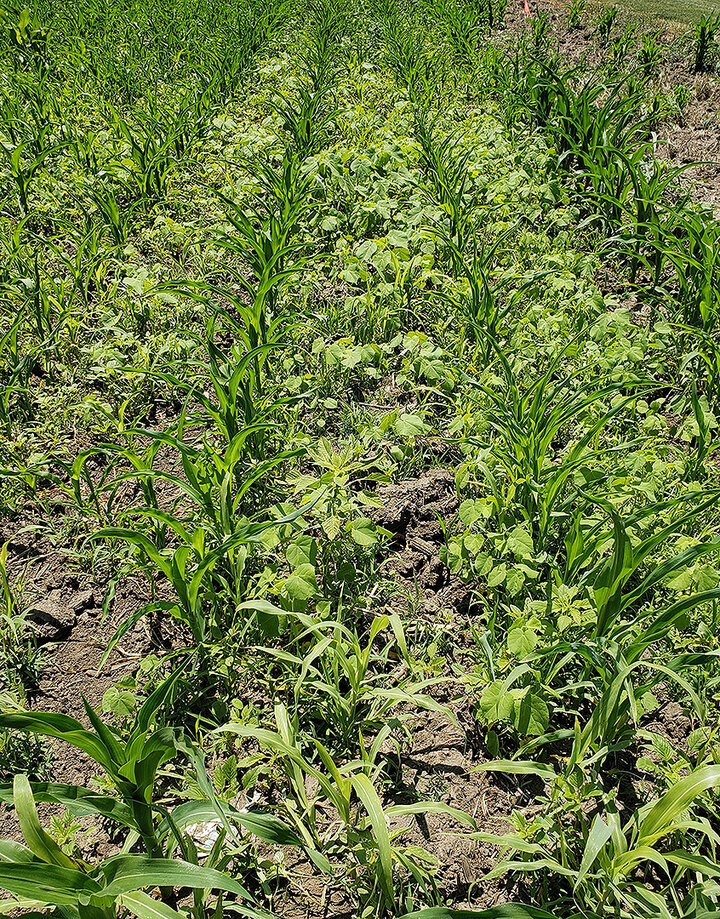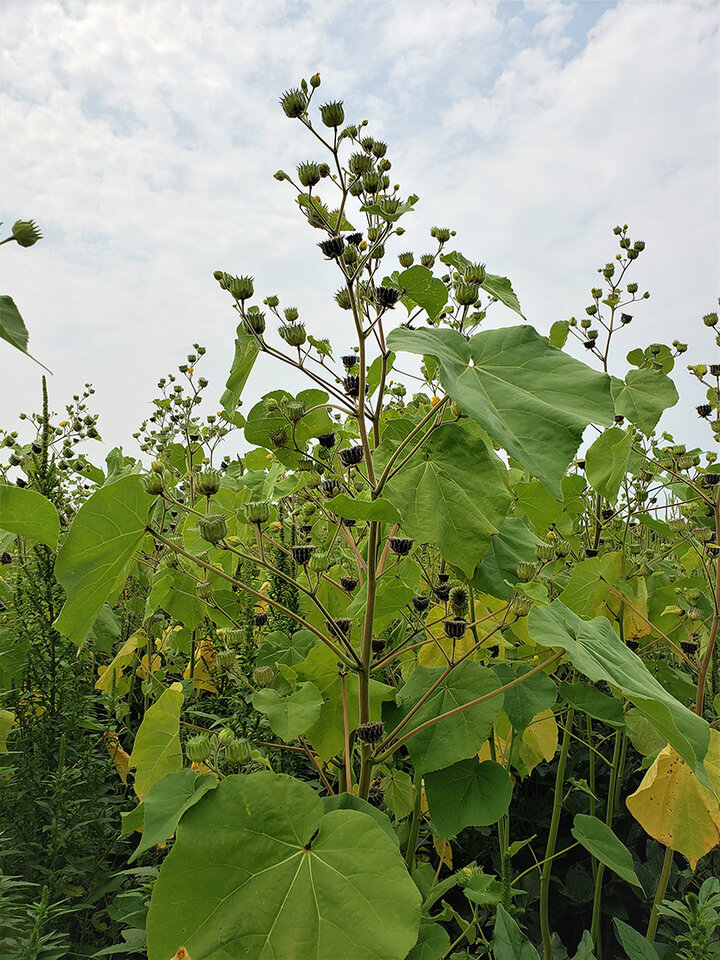Introduction
Nebraska is the No. 1 popcorn-producing state in the United States. Popcorn is grown on approximately 60,000 acres annually in Nebraska. Popcorn production is normally contracted by the popcorn processor and the farmer. Popcorn growth and development varies from field corn in several ways: Popcorn has shorter and thinner stalks, narrower and more upright leaves, and slower emergence than field corn. Because of these characteristics, popcorn is less competitive with weeds than is field corn.

Velvetleaf is a large-seeded annual broadleaf weed native to China, where it was cultivated as a fiber crop. It was introduced to North America in the 17th century for fiber production. Velvetleaf is now a major agricultural weed in corn, cotton, soybean and sorghum production fields in North America. Velvetleaf is a competitive weed and can reduce grain yield if not controlled (Figure 1). A statewide survey conducted in 2015 reported velvetleaf as the fourth most difficult to control weed in Nebraska (Sarangi and Jhala 2018).
Widespread occurrence and seed-bank persistence of velvetleaf contributes to its longevity and long-term success. A study in Nebraska reported 25% and 35% viability in eastern and western Nebraska, respectively, after 17 years of velvetleaf seed burial (Burnside et al. 1996). Its growth potential and canopy architecture enable velvetleaf to compete for light with most agronomic crops (Figure 2).
The majority of popcorn production in Nebraska is under conservation tillage systems and herbicides are the primary method of weed control. Weed control is a challenge for popcorn producers because there are fewer herbicide options compared with field corn and there are no herbicide-resistant popcorn cultivars available.
Objectives
(1) To evaluate the efficacy and crop safety of labeled post-emergence herbicides for controlling velvetleaf that survived Dual II Magnum applied pre-emergence in Nebraska popcorn.
(2) To determine the effect of velvetleaf height on post-emergence herbicide efficacy.

Materials and Methods
Field experiments were conducted at the University of Nebraska-Lincoln, South Central Agricultural Laboratory near Clay Center, Nebraska in 2018 and 2019. The treatments were arranged in a split-plot design with four replications. The main plot treatments consisted of two velvetleaf heights (≤6-inch and ≤12-inch tall) and 11 subplot POST herbicide programs (Table 1). A no-POST herbicide control was included for comparison. Plot dimensions were 9 meters long by 3 meters wide. A yellow popcorn hybrid (VYP 321; Conagra Brands, Chicago, Illinois) was planted on April 30, 2018, and May 1, 2019, with a row spacing of 30 inches. S-metolachlor/atrazine (Bicep II Magnum) was applied using a tractor sprayer to treat the entire research site to achieve early season control of small-seeded weeds. This pre-emergence herbicide resulted in high survival rate of velvetleaf and low survival rate of other weed species.
Results
- Velvetleaf control 14 days after treatment varied across years and an interaction between velvetleaf height and herbicide program occurred in both years of the study; however, at 28 days after treatment in 2019, velvetleaf height did not affect herbicide efficacy (Table 1).
- Most herbicides controlled velvetleaf 95% or greater at 14 and 28 DAT regardless of velvetleaf height at application.
- Cafentrazone, fluthiacet-methyl, dicamba, dicamba/diflufenzophr and fluthiacet-methyl/mesotrione resulted in 95% or greater control 14 DAT regardless of velvetleaf height at the time of application in 2018 and 2019.
- In 2018, 88% to 94% control of velvetleaf was achieved with dicamba/tembotrione and 99% in 2019. Similarly, control of velvetleaf at 14 days after treatment with nicosulfuron/mesotrione (99%) and dicamba/halosulfuron-methyl (96% to 99%) in 2019 was greater than control with nicosulfuron/mesotrione (84% to 92%) and dicamba/halosulfuron-methyl (86% to 90%) in 2018.
Orthogonal contrasts indicated that herbicide programs with fluthiacetmethyl or dicamba resulted in greater control of velvetleaf than herbicide programs without them in 2018 (data not shown). In 2019, herbicide programs with or without fluthiacet-methyl or dicamba resulted in similar control of velvetleaf at 28 DAT.
Table 1| Velvetleaf control 14 DAT 2018 | Velvetleaf control 14 DAT 2019 | Velvetleaf control 28 DAT 2018 | Velvetleaf control 28 DAT 2019 | |||||
|---|---|---|---|---|---|---|---|---|
| Herbicide programa | Rate | Velvetleaf heightb up to 6 inch | Velvetleaf heightb up to 12 inch | Velvetleaf heightb up to 6 inch | Velvetleaf heightb up to 12 inch | Velvetleaf heightb up to 6 inch | Velvetleaf heightb up to 12 inch | Velvetleaf heightb up to 12 inch |
| g ai ha─1 | --%-- | |||||||
| No-POST herbicide | --- | 0 e | 0 g | 0 b | 0 c | 0 e | 0 f | 0 b |
| Carfentrazone-ethyl | 17.5 | 98 a | 98 ab | 99 a | 99 a | 98 a | 98 ab | 99 a |
| Fluthiacet-methyl | 7.2 | 99 a | 99 a | 99 a | 99 a | 98 a | 99 a | 99 a |
| Topramezone | 24.5 | 91 abc | 64 f | 99 a | 98 a | 94 ab | 69 e | 99 a |
| Tembotrione | 98 | 81 d | 80 e | 99 a | 81 b | 80 d | 86 d | 99 a |
| Halosulfuron-methyl | 52.5 | 84 cd | 90 bcd | 99 a | 95 a | 85 cd | 91 bcd | 99 a |
| Dicamba | 560 | 96 a | 95 abc | 97 a | 97 a | 98 a | 98 ab | 99 a |
| Dicamba/diflufenzopyr | 392 | 98 a | 97 ab | 99 a | 99 a | 97 a | 99 a | 99 a |
| Dicamba/tembotrione | 597 | 94 ab | 88 cde | 99 a | 99 a | 97 a | 95 abc | 99 a |
| Fluthiacet-methyl/mesotrione | 2.8 | 99 a | 98 ab | 99 a | 99 a | 99 a | 98 ab | 99 a |
| Nicosulfuron/mesotrione | 118 | 92 abc | 84 de | 99 a | 99 a | 96 a | 90 cd | 99 a |
| Dicamba/halosulfuron-methyl | 190 | 86 bcd | 90 bcd | 99 a | 96 a | 89 bc | 92 bcd | 99 a |
| P-Value | ||||||||
aThe experimental site was treated with Bicep II Magnum applied pre-emergence including the no-POST control plots.
bMeans presented within the same column with no common letter(s) are significantly different according to Fisher’s Protected LSD where α = 0.05.
Take Home Message
- Velvetleaf was effectively controlled by a number of post-emergence herbicides tested in this study at heights ranging from six to 12 inches. Cadet or Aim provided 98% to 99% control and are labeled for velvetleaf up to 91 and up to 62 cm tall, respectively.
- DiFlexx or Status provided 95% or greater velvetleaf control. From the results of this study, we conclude that effective POST herbicides are available for control of six- to 12-inch tall velvetleaf in popcorn production.
- For more information, read this paper.
References
Burnside OC, Wilson RG, Weisberg S, Hubbard KG (1996) Seed longevity of 41 weed species buried 17 years in eastern and western Nebraska. Weed Science 44:74–86
Sarangi D, Jhala AJ (2018) A statewide survey of stakeholders to access the problem weeds and weed management practices in Nebraska. Weed Technology 32:642-655
